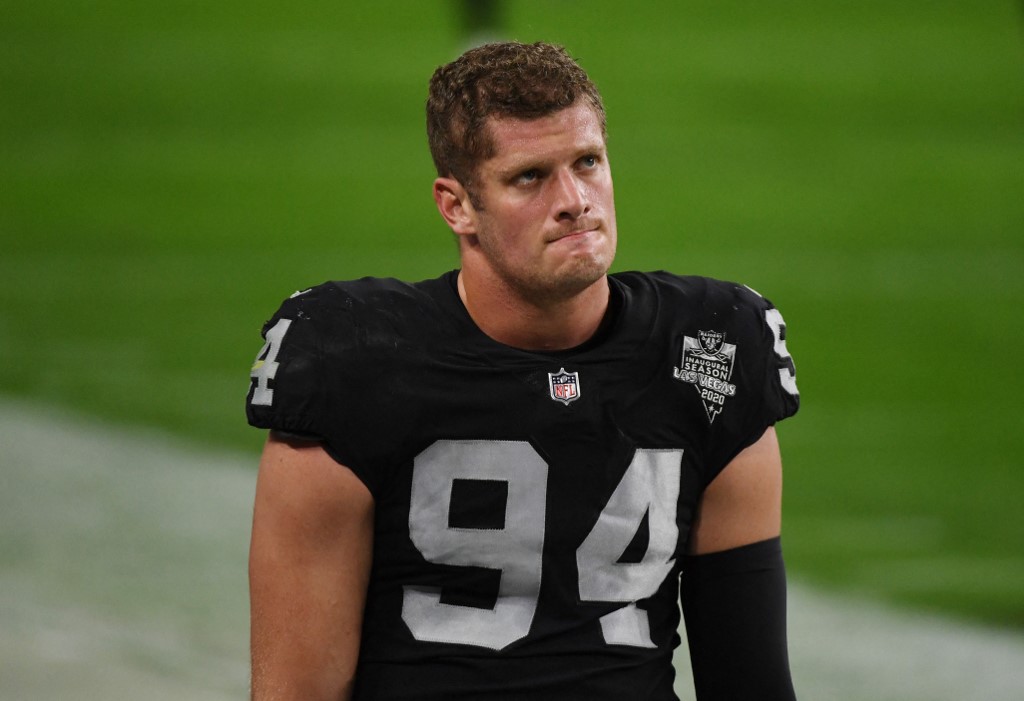
LAS VEGAS, NEVADA – DECEMBER 17: Defensive end Carl Nassib #94 of the Las Vegas Raiders reacts after the Los Angeles Chargers score during the first half at Allegiant Stadium on December 17, 2020 in Las Vegas, Nevada. Ethan Miller/Getty Images/AFP (Photo by Ethan Miller / GETTY IMAGES NORTH AMERICA / Getty Images via AFP)
When Las Vegas Raiders’ defensive end Carl Nassib came out as the first gay active National Football League player it opened a door for the LGBTQ community but also exposed a lack of inclusiveness in professional sport locker rooms.
Nassib’s announcement on Monday, during Pride month, was greeted with support from the league and his team, which praised the 28-year-old’s courage as a trailblazer.
Combined North America’s five biggest men’s professional leagues, the NFL, National Basketball Association, National Hockey League, Major League Baseball and Major League Soccer have 150 franchises spread across the United States and Canada.
Of those Nassib is the only openly gay player.
“There is a real culture change that needs to happen,” Cathy Renna, a spokeswoman for the National LGBTQ Task Force said. “When we talk about toxic masculinity, locker rooms are one of the last bastions particularly for sports like football and hockey.
“This is another watershed mark but the road to acceptance and the progress we are looking for takes a lot of time and taking longer in some sports than others.”
In contrast to men’s professional sports, professional sportswomen have been coming out as lesbian for decades.
The NFL had been on the cusp of a similar historic moment seven years ago when Michael Sam came out as gay ahead of the 2014 NFL Draft.
He was selected with the eighth-to-last pick by the St. Louis Rams but never appeared in a regular season game.
Robbie Rogers was the first openly gay male to play in a major men’s professional American sport when he returned to Major League Soccer, signing with the LA Galaxy shortly after coming out in February 2013.
In April the same year, Jason Collins, late in his 13-season NBA career, made history when he became that league’s first active athlete to come out publicly.
In 2014 he signed with the Brooklyn Nets and would play 22 games in a backup role before retiring later that year.
There are no active openly gay players in the NHL or MLB.
“None of these players think they don’t have LGBTQ teammates, they know they do,” said Renna. “The reality is that they have to learn that it is like any work place, they have to create an atmosphere of respect and inclusivity.
“Locker rooms seemed to get a pass on that for a long time.”
Leagues and teams have long marketed to the LGBTQ community with Pride Night promotions and participating in events such as Pride parades.
But rarely have LGBTQ fans had a member of their community to identify with and support.
Marketing experts believe there will be areas where both the NFL and Nassib to benefit.
“He’s gone from having zero marketing potential to having some marketing potential,” said Bob Dorfman, a sports marketing expert at Baker Street Advertising in San Francisco. “And I’d like to think that the NFL would use him as a standard-bearer to promote sexual equality, racial equality, just generally treating people as equals no matter what your preferences are.”
RELATED STORIES
Read Next
Subscribe to INQUIRER PLUS to get access to The Philippine Daily Inquirer & other 70+ titles, share up to 5 gadgets, listen to the news, download as early as 4am & share articles on social media. Call 896 6000.
For feedback, complaints, or inquiries, contact us.















































